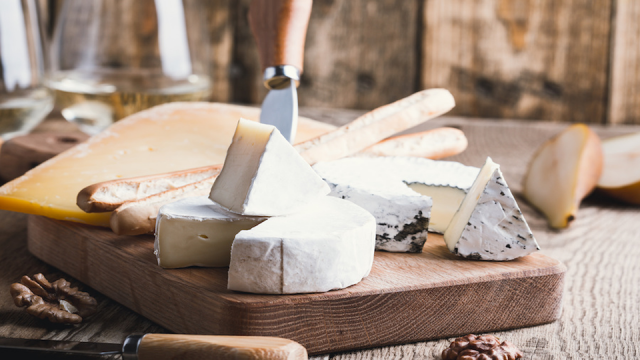
Oh, for the love of cheese, it is just so darn good. But, is it good for us? That is a loaded question. There is cheese, and then there is cheese. Choosing the right cheese can make all the difference, and knowing how to spot an imposter will help you stay on track this holiday season when you put together the perfect healthy holiday cheese platter.
The “cheese” you don’t want on your holiday platter
The industrialization of food has robbed cheese of its dignity, and that’s not all – it has created a monster. You can spray it, you can pull it, and you can spread it, but what is it exactly?
“It” is… highly processed, industrially produced and digestible product that contains no real food. Processed cheese is essentially a cleverly engineered and mass produced product that is designed to taste good and perform well in the mass food market at a very low cost. Some processed cheese is so artificial that it cannot be legally labeled as “cheese,” so it is referred to as “cheese food,” “cheese spread” or “cheese product.” These imposters are entirely unhealthy and deserve no place on your holiday cheese platter this year. Just say no!
The cheese you do want on your holiday platter
REAL cheese is essentially fermented milk, made from straightforward ingredients: milk, salt, bacterial culture, and rennet (an enzyme). Because the milk is fermented, lactose is almost nonexistent in cheese. This is the element that most commonly causes intolerance to dairy. In the cheesemaking process, bacteria convert lactose into lactic acid. If you want to avoid even trace amounts of lactose, stick with longer-aged cheeses since these have the lowest levels.
REAL cheese is also highly satisfying and satiating due to the balance of protein and fat, and it adds delicious flavor to dishes. Adding fat such as cheese to vegetables allows us to absorb more nutrients from the vegetables because many nutrients are fat-soluble rather than water-soluble.
Additional health benefits of eating real cheese
Despite decades of medical establishments recommending a reduced or nonexistent intake of unpasteurized and high-fat dairy, recent research has found that the hearty traditional cheeses commonly eaten in France and other parts of Europe have additional health benefits. Let’s take a quick peek before we build our platter.
Cancer protection: Raw grass-fed dairy contains high levels of conjugated linoleic acid (CLA), which has been shown to have anticancer properties. Grass-fed cheese contains about five times the CLA of grain-fed cheese. This is a good reason to invest in high-quality cheese originating from healthy animals.
Vital Nutrients: When cows (or sheep or goats) are allowed to roam free in the sun, eating green grass, their milk contains incredible levels of the fat-soluble vitamins A, D, E, and K2. These nutrients are understood to support strong immunity, well-formed teeth and bones, and robust eye health.
Gut bacteria and food safety: The friendly bacteria naturally contained in cheese can enhance the gut microbiome and improve healthy immune response. Microorganisms on cheese not only preserve the final product and make it aromatic and delicious, but they are also very important for food safety. Many of the bacteria on the rind prevent the spread of potentially dangerous pathogens by excreting inhibitors against other unfriendly bacteria, such as listeria.
Reduced risk of heart problems: Cheese bacteria may help lower heart disease risk. A French study found that those who consume cheese have higher fecal levels of butyrate, a byproduct produced by good gut bacteria. These people also had healthier cholesterol profiles, indicating that the probiotics in cheese help balance the microbiome for improved cardiovascular health.
Building the perfect healthy holiday cheese platter
Here are 5 of the healthiest and tastiest cheeses that you can use to build a holiday platter that friends and family will rave about. Remember to keep it real, organic, and raw if possible.
Goat Cheese
Goat cheese does not contain A1 casein found in most cow’s milk, so it is easy to digest and is packed with vitamins, minerals, and healthy fat.
Pecorino Romano
This hard cheese is made from sheep milk and has been enjoyed since ancient Roman times. In Italy, it is still made using the original recipe. Sheep milk is richer in fat than cow or goats milk. There are seven grams of protein in just one ounce of Pecorino Romano.
Sheep/Goat Feta
Feta cheese made from sheep or goat milk is high in calcium, riboflavin, phosphorus, vitamin B12, and selenium. Feta made from sheep or goat milk is easy to digest and is less inflammatory than feta made from cow’s milk.
Ricotta Cheese
Ricotta made from goat or sheep milk is a tasty addition to any cheese platter. This cheese has a hint of sweetness and is creamy without being too filling. Ricotta is low in sodium and contains healthy fatty acids, vitamin A and calcium.
Parmesan
Besides being packed with protein, parmesan cheese contains a good amount of vitamin A. Parmesan cheese is a rich source of amino acids, including tryptophan, which is necessary to produce neurotransmitters including serotonin and melatonin. Serotonin is also known as the feel-good hormone and helps to boost moods. Melatonin is associated with restful sleep. It’s sharp and nutty flavor often make it a party favorite.
Here’s to your perfect healthy holiday cheese platter!
-Susan Patterson

